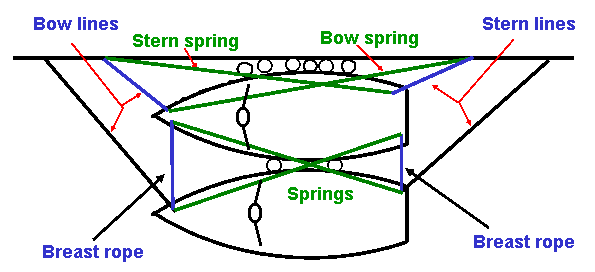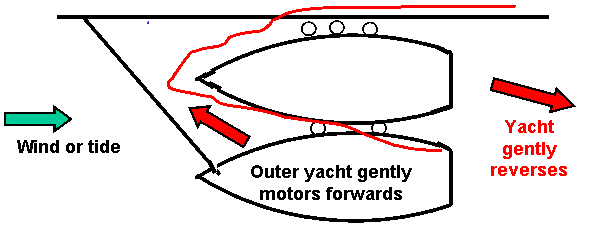Ideally when you moor a yacht up on an alongside berth you will have plenty of space and not have to share the dock or pontoon with another vessel. In the UK it is common to moor up alongside other vessels during the season when berthing spaces are at a premium. This can make for some interesting moments! It also gives you the opportunity to meet and talk to interesting people from all over the World.
Pontoon berthing
Before approaching the pontoon it is a good idea to drive past to check the arrangement with the mooring cleats or bollards, if you have an inexperienced crew this is a good time to brief them as to where the mooring ropes should end up.
The skipper should ensure that the fenders are attached at the correct height for the dock, and that they are correctly spaced along the length of the vessel. It is not unusual for the fenders to be concentrated on the center of the vessel, in fact, they should be spread out along the length of the boat. A good guide is that the front one should be between the pulpit and the first guardrail stanchion, the last fender should be at about the rear stanchion. This spacing ensures that the boat is adequately protected when first arriving, the front section of the vessel is the part that will contact the dock when you first arrive, especially if you get the angle of approach slightly wrong.
The mooring ropes need to be prepared, they should be long enough without being unwieldy, if the crew have 3 or 4 coils in their hands when they stand at the shrouds they have about enough slack rope to be able to do their job correctly. The ropes must be run under the guardrails!
The yacht should approach the pontoon heading in to the tide or the wind if there is not tide, if the angle of approach is between 35° and 40° the boat should be able to enter most berths, as the bow closes with the pontoon the vessel should turn away so that the stern swings in and reverse should be applied to stop the boat completely.
Once stopped the crew with the ropes need to attach them to the mooring cleats on the pontoon as soon as possible to ensure the boat does not move.
Bow and stern lines
The bow and stern lines are normally the first ropes made off and for a short stay such as refuelling they may be adequate. If the boat is left moored on these two lines only it will tend to twist and surge back and forth on the dock.

Springs
Modern yachts tend to sit with their bows angled in towards the pontoon. If springs are rigged correctly they will allow you to adjust the boat's position until it is parallel to the berth.
Alongside another vessel
When it is busy you will need to moor alongside another vessel. Try to pick one that is the same size or larger and of a similar type. Sailing yachts do not sit well alongside most motor vessels because of their different shapes. Before coming alongside it is normal to ask permission and to brief the crew on what is expected, especially if you are arriving in the middle of the night! A good crew can moor to another vessel without waking them up.
During busy times I will have worked out when I intend to be leaving the next day, then it may be possible to pair up with a vessel leaving at the same time. In many tidal areas there will be two likely times that vessels will be leaving, each one depending on when the tide turns in the right direction for the next port along the coast.
You will need breast ropes between the bows and sterns of the two boats, and springs, then it is normal to rig some shore lines for each boat. By doing this the load is shared between all the yachts, especially when there is a strong tide or offshore wind. The most boats I have ever seen rafted up was 14, imagine the weight on the inside vessel's lines if they were the only one attached to the quay!

Do not forget to look up in the air when moored alongside, make sure that the masts and spreaders are offset fore and aft. If they are not and a large vessel goes past you may roll and strike the masts together. On one occasion my boat rolled and the mast went under the backstay of the boat next to me, as both vessels were over 32ft it was not easy to tip them enough to be able to release them.
Departing when rafted up alongside
Leaving from an inside berth when you are rafted up can be very tricky. The best approach is to try to have the boats arranged on the quay in the order in which they intend to leave, especially if one is leaving at an inconvenient time. This may mean everyone leaving the dock, then returning in the appropriate order.
When you have a vessel outside you when you intend to leave, you will need to depart down wind or down tide if there is a tide running, this is contrary to the normal approach. If you attempt to leave the berth by going in to the current or the wind (if no current) it is likely the outside boats will all swing away from the quay and be unable to get back in position
The first step once everyone in the line of boats have their engines running is to remove all the unnecessary warps. Each boat should only have bow and stern lines made fast to the shore.
The boat immediately outside the one departing needs to run one rope from their stern right round the inside boat, making sure it does not foul any fittings. Then as the inner vessel reverses gently back the outer vessel can motor slightly forwards, and take up the slack on the bow and new stern line.

Just to make things interesting, there will be different opinions about how to do this and probably several different languages being spoken!
Sailtrain.co.uk is free to use, but if you feel you would like to contribute to the running and development costs you can donate via Paypal:
Additional Resources:


